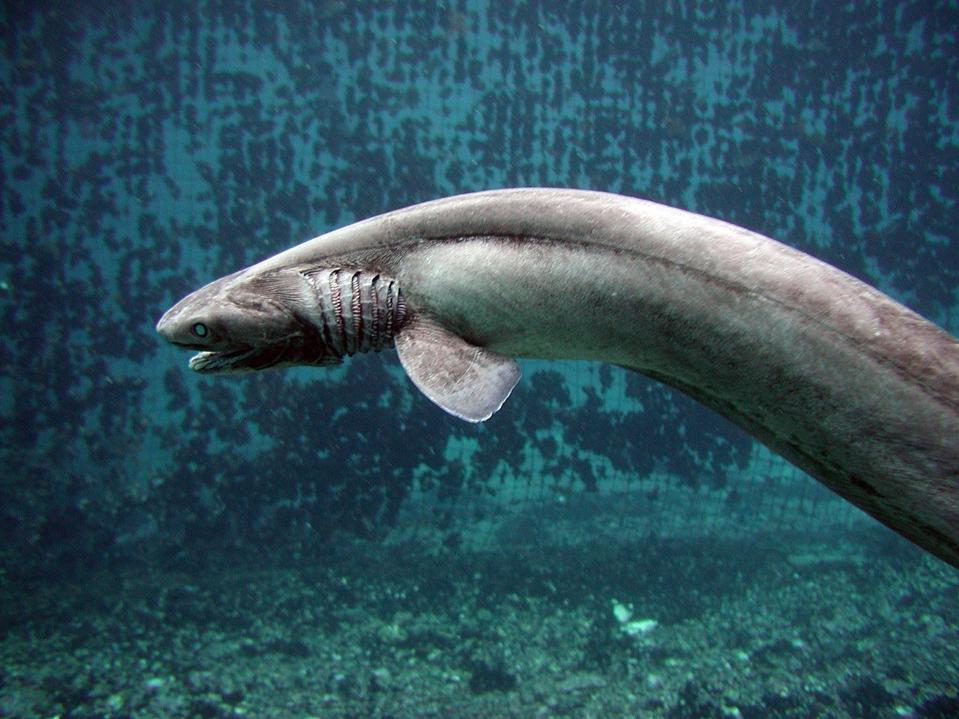First described in 1884, the frilled shark (Chlamydoselachus anguineus) is one of those deep-sea creatures that looks like it swam straight out of prehistoric times. And, to be honest, in many ways it did. With an elongated, eel-like body, six gill slits on each side of its head, and rows of trident-shaped teeth, this species has changed little over millions of years. Often called a “living fossil,” it typically lives in deep waters between 400–4,900 feet (120–1,500 meters), where it’s rarely encountered by people. Despite its wide but scattered distribution in the Atlantic and Pacific Oceans, very few frilled sharks have ever been observed or collected. Fewer than 40 specimens have been documented since it was first described, making each new find scientifically valuable.
In a recent study, researchers reported a rare discovery: a male frilled shark caught off Chiloé Island in southern Chile. Not only is this the first confirmed male of the species recorded in Chilean waters, it also extends the known range of the frilled shark in the southeast Pacific by roughly 530 miles (850 kilometers) southward. Until now, only one other frilled shark had been reported off the Chilean coast: a female caught off Concepción in 1976, which is now held at the Museo Nacional de Historia Natural de Chile.
The new male specimen was caught incidentally in 2015 by a fishing vessel operating near Cucao, off the west coast of Chiloé Island, at a depth of about 1,640 feet (500 meters). The shark was preserved in formalin and held in a private collection until researchers were granted access to it in 2023. While the preservation process had affected the coloration of the shark, turning its normally dark brown skin lighter, many physical features remained intact and were carefully measured by the team, led by Maria J. Indurain of the Programa de Conservación de Tiburones, Universidad de Antofagasta. In total, 48 body measurements were taken to compare this male to the previously known female specimen, as well as to frilled sharks documented in other parts of the world.
Interestingly, the two Chilean specimens shared no significant morphological differences, but the researchers did find some anatomical variation when comparing them to specimens from other regions, especially those from Japan. For instance, the Chilean sharks had longer heads and smaller pelvic fins relative to their total body length. These differences fall within the known range of variation for the species but could also be influenced by sexual dimorphism or even preservation methods. In males, for example, pelvic fins can be proportionally larger than in females. Still, the sample size is too small to draw any firm conclusions, and the research team noted that further studies would be needed to determine whether these differences are typical of the region’s frilled shark population.
The male specimen was also determined to be sexually mature based on the presence of calcified claspers and developed testes, which is exciting news as mature males are especially rare among the frilled shark specimens recorded globally. Only eight have ever been documented! The female specimen, unfortunately, could not be assessed for maturity since it no longer contained internal organs. No genetic testing could be done on either specimen due to the deteriorating effects of the formalin used for preservation, which breaks down DNA over time. Despite these limitations, the study contributes important data to a field where much remains unknown. The frilled shark is listed as “Least Concern” by the International Union for Conservation of Nature, but this doesn’t necessarily mean it is thriving. The assessment is based on very limited data, with no estimates of population size, structure, or trends. The shark is occasionally caught as bycatch in deep-sea fisheries, but sightings are so rare that each record adds meaningful information. This latest discovery could help refine what we know about the species’ distribution, especially in the understudied waters of the South East Pacific.
Going forward, the researchers suggest an integrated approach to frilled shark studies — looking into museum holdings, bycatch reports, and private archives — to continue piecing together the puzzle of this ancient, elusive shark.

